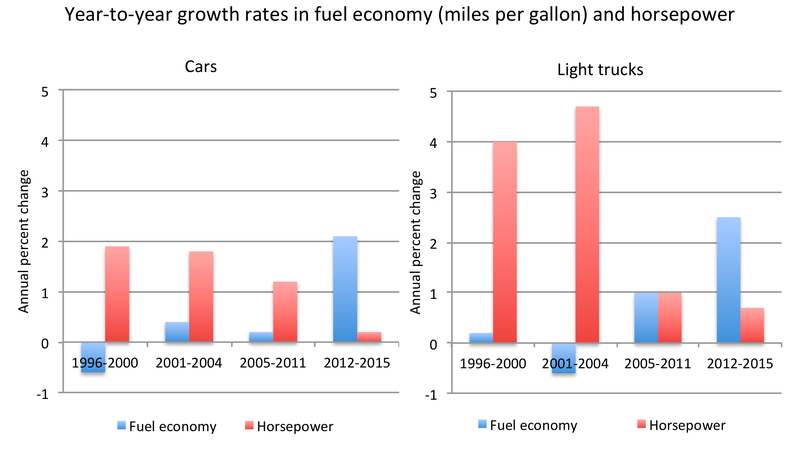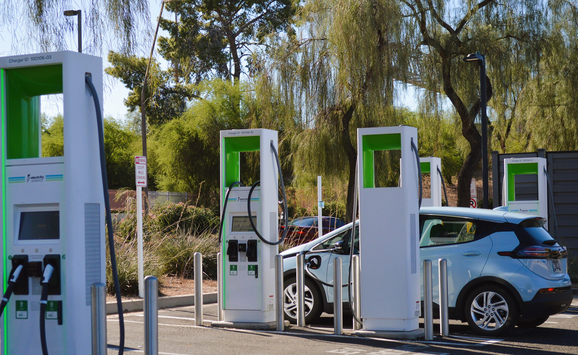Over the next year, the US Environmental Protection Agency and Department of Transportation will finalize standards for new passenger vehicle fuel economy and greenhouse gas emissions through the year 2025. The joint standards came into effect in 2012 and have been highly controversial. Proponents of tighter standards claim that, in addition to the related climate change and energy security benefits, new vehicle buyers benefit from improved fuel savings. Critics argue that tighter standards could also harm new vehicle buyers if they do not want as much fuel economy as the standards require.
However, in new research we show that the standards have had approximately zero net effect on the well-being of new vehicle consumers. We considered two opposing effects of tighter standards on consumer well-being, with regard to fuel savings and vehicle performance, and find that the benefits to consumers from greater fuel savings are roughly offset by the costs of trading off performance for fuel economy. (Note that our analysis does not include public benefits related to climate change and energy security; more on this below.)

Let’s start with fuel savings. The standards may benefit new vehicle buyers by addressing what is known as the energy efficiency gap for fuel economy. The gap refers to the fact that both new vehicle manufacturers and consumers appear not to adopt fuel-saving technologies—even when the value of the resulting fuel savings exceeds the cost of doing so. Tighter standards encourage manufacturers to add these technologies to their vehicles. As we explain below, our analysis suggests that for consumers, the benefits from spending less on gasoline exceed the direct costs of purchasing new vehicles with fuel-saving technology (which are typically more expensive than vehicles without it).
But consumers also care about vehicle performance. Because the agencies provide flexibility to achieve the standards, manufacturers can take advantage of the technological trade-off between fuel economy and performance (such as horsepower, which affects towing capacity or the time needed to accelerate from 0 to 60 miles per hour). When standards tighten, manufacturers may in fact use technologies to raise fuel economy instead of performance.
For example, between 1985 and 2005, when fuel economy standards were effectively unchanging, Honda adopted a number of fuel-saving technologies that allowed it to increase the engine size of its Civic model—doubling horsepower without sacrificing fuel economy. If standards had been tightening during that period, however, Honda could have used those same fuel-saving technologies to raise fuel economy rather than performance. In that case, tighter standards would have caused new vehicle consumers to forgo performance improvements.
Manufacturers can use these trade-offs to complement other approaches to raising fuel economy. For example, recent research also shows that tighter standards increase the rate at which manufacturers adopt fuel-saving technology.
Tighter standards haven’t reduced horsepower in absolute terms, but they have caused horsepower to be lower than it would have been. Figure 1 illustrates the pattern. The vertical lines indicate when the standards tightened for cars and light trucks. For cars, between 1996 and 2011, the standards were about 27 miles per gallon. During that time, manufacturers steadily increased horsepower (red bars) and left fuel economy (blue bars) essentially unchanged. After 2011, when the standards began tightening, fuel economy increases but horsepower does not. Light trucks show a similar pattern. Standards were unchanged from 1996 through 2004. During this time, horsepower increased about 4 percent per year while fuel economy was flat. The standards began increasing slowly between 2005 and 2011, and then more quickly after 2011. Horsepower stopped increasing as quickly as it had been, and fuel economy increased more quickly.
Figure 1. Year-to-Year Growth Rates in Fuel Economy (miles per gallon) and Horsepower
In our new report, we focus on consumer valuation in response to changes in fuel economy and performance that occurred in the 2010s, when fuel economy and emissions standards began tightening. In contrast, many recent studies have focused on consumer responses to fuel price changes in the 1990s and early 2000s, when fuel economy standards were not changing. Moreover, most past research on performance valuation has assumed that performance is uncorrelated with other attributes of a vehicle. This is probably not a good assumption because manufacturers choose a vehicle’s performance at the same time as they choose many other attributes, such as 4-wheel or front-wheel drive.
Our analysis indicates that new vehicle consumers undervalue fuel savings, paying about 54 cents for 1 dollar of future fuel savings. This undervaluation is consistent with an energy efficiency gap, and suggests that tighter standards benefit consumers. However, we find that consumers are willing to pay about $1,100 for a 1-second reduction in the time needed to accelerate from 0 to 60 miles per hour (a performance improvement of about 12 percent). Because consumers value performance so highly, the requirement for greater fuel economy means consumers must give up performance, leaving them worse off.
On balance, tighter standards have had approximately zero effect on new vehicle buyers—the benefits to those consumers of addressing the energy efficiency gap and reducing fuel costs are roughly offset by the consumer costs of trading off performance for fuel economy.
We emphasize that these results do not mean that the tighter standards have harmed the public. Our analysis does not include the societal benefits of lower greenhouse gas emissions and better energy security. Given the possibility that the energy security benefits of lower oil consumption may be lower now than they used to be, our results suggest that the chief benefits of tighter standards may be to reduce US greenhouse gas emissions and help lay a foundation for international efforts to reduce the costs of climate change.








